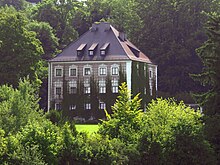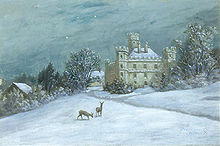Berg Palace (Bavaria)
This article needs additional citations for verification. (May 2014) |

Berg Palace (
History

The building was built in 1640 in the style of an Italian Renaissance villa by Hans Georg von Hörwarth on the site of an older manor house. Hörwarth came from an Augsburg patrician family that had previously owned several properties in the area.[1] The manor house is located on the shore of Lake Starnberg, opposite Possenhofen Castle.
Baroque period
-
The hunting lodge with a formal Baroque garden around 1700
In 1676 Ferdinand Maria, Elector of Bavaria, acquired the estate from the Hörwarth family. He used it as a hunting lodge, for excursions from his summer castle in Starnberg, and for festivities. It reached its zenith under his successors, elector Max Emanuel, who sailed on the lake with a fleet of magnificent ships, and Emperor Charles VII, when it served as the ambiance for spectacular entertainment and hunting events.[2]
-
Starnberg Castle and the fleet of magnificent ships, led by the Bucentaurus, a copy of the ship of the Doges of Venice (around 1700).
19th century


Between 1849 and 1851 King
Ludwig II used the site as his summer residence, moving here regularly every year on 11 May. For this purpose he established a telegraph line from Berg to the capital Munich.
In 1868 the Czarina of Russia Maria Alexandrovna visited Berg upon the King's invitation. Ludwig made it her residence for the duration of her visit and had it magnificently decorated for the occasion, as the site was otherwise rather modestly appointed by Ludwig's standards. He held a legendary festival in her honor with lanterns throughout the park and fireworks.
The surrounding park was fashioned and cultivated by his predecessors according to contemporary ideas of garden design, from a formal Baroque garden to an English landscape garden. Ludwig had the "Moorish Kiosk" set up here which Franz von Seitz had designed and built for the Winter Garden on the roof of the Munich Residenz.[3] In 1876 the King had a small chapel built.
On 12 June 1886, Ludwig, after he had just been declared mentally impaired and incapable of ruling and his uncle Luitpold having been appointed regent, was transferred to Berg Palace. On June 13 he and his physician Bernhard von Gudden were found dead in the shallow waters at the banks of Lake Starnberg. The deaths remain contested, despite the official statement of drowning. A votive chapel and a memorial cross in the lake's shallows mark the site since.
-
Postcard (around 1900) with the interned King Ludwig II and his psychotherapist Gudden on a walk in the park that ended fatally for both of them.
-
View through the park to the lake where a cross marks the spot in the shallow water where Ludwig II's body was found on 13 June 1886.
20th century to today
After the king's death the house, still owned by the royal family, became a museum and in 1939 was declared a monument, as it had not been changed since Ludwig's death, and thus acquired not only a historical but also a cultural significance.[2]
After
Notes and references
- ^ Website of Berg municipality
- ^ ISBN 978-3-8307-1019-6.
- 1867 Paris Exhibition.
- ^ "Schloss Berg". Gemeinde Berg. Retrieved January 25, 2020.




